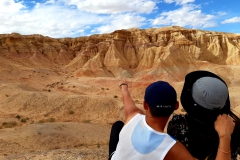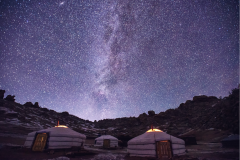8 days
The Gobi is the fifth largest desert in the world, sprawling across southern Mongolia and northern China. After the first fossilized dinosaur egg was found in Mongolia in the 1920s, the Gobi attracted global attention. “Gobi” in Mongolian means desert, but millions of years ago, the Gobi was a rich oasis, supporting entire ecosystems.
Why Gobi?
- It is home to some of the most unique and rare animals in the world.
- The desert contains Paleolithic and Neolithic sites, once occupied by ancient peoples.
- Surprisingly, much of the Gobi is not sandy desert but bare rock, an incredible opportunity for geologists to study.
Itinerary:
Day 1: Baga gazriin chuluu 270 km
We can enjoy exploring this big granite stone massif in southern Mongolia in the first day. Baga gazriin chuluu is 300 square kilometers of big granite stone massif. Many historical and valuable items were found here, such as rock paintings, burial mounds, and evidence of other rituals.
Day 2: White stupa 240 km
Millions of years ago, the White stupa was an ancient seabed, which is now famous for its gorgeous and colorful slopes. The name “White Stupa” is originated because the rock formation looks like a palace, or row of stupas from a distance.
Day 3: Yol valley 210 km
It is a narrow gorge surrounded by rocky cliffs. Once we get to the gorge, we will hike about 2km on either side of the valley, totaling 4 km. In this area, most of steep rock walls see little sun light, therefore walking through the gorge will be refreshing compared to the hot Gobi sun.
Day 4: Khongor sand dune 210 km
Although the Khongor sand dune isn’t exceptionally tall, (less than 200m), climbing will take more than an hour because of how slippery it is. This is an absolutely thrilling and unique experience.
Day 5: Bayanzag and Flaming cliffs 150 km
We will visit a small forest of saxual trees. Saxaul trees are native to the Gobi, growing with only a small amount of water. Close to the small forest of trees, there is a famous paleontological site: Flaming Cliffs, which refers to the sandstone’s beautiful orange and red color (especially during sunset). In the 1920s, an American expedition, led by Roy Chapman Andrews, worked in the Gobi, and they found the first fossilized dinosaur egg in the Flaming Cliffs.
Day 6: Ongi monastery ruin 170 km
It is our last day in the Gobi before heading back to Central Mongolia. This day, we will see the ruins of the old monastery, which was home of over a thousand monks. This famous monastery was almost completely destroyed by the communist purges in the 1930s. However, many visitors comment about the indescribable energy and feeling the ruins give off, therefore many people like to hike and meditate in the area.
Day 7: Kharkhorin / Kharkhorum 260 km
Due to the long day of traveling on dirt road, we will leave the camp earlier this day. On this day, we will drive to Kharkhorin town, where the Mongol Empire’s capital- Kharkhorum was existed! Upon arriving, we will go to both the Kharkhorum museum and Erdenezuu monastery. The Kharkhorum museum contains amazing displays of archeological finds from the Orkhon Valley area, which is listed on the World Heritage site by UNESCO. We will learn exciting historical facts and see ancient artifacts in this museum.
Erdenezuu is the first Buddhist Monastery in Mongolia, founded in 1586. Even though the monastery construction began in the 16th century, Erdenezuu was originally built with ruins of Kharkhorum city (13th century), making it over 800 years old!
Day 8: Khustai National Park 300 km
Next we will visit the Khustai national park, this protected area is home to an astounding 459 species of plants, 126 species of birds, and 44 species of mammals, including red deer, Mongolian gazelle, roe deer, grey wolf, lynx, and red fox. When visiting this park, we will be fortunate enough to observe the Przewalski wild horses! Mongolia is the home of the Prezewalski horse, which made a remarkable recovery from their extremely endangered status in the 19th and 20th centuries. These unique horses were transported to Europe for decades, severely threatening their survival as a species. Between 1992-2001, the Takhi (another term for Przewaslki) were reintroduced into Khustai National Park from Europe by a Dutch foundation. A total of 84 Przewalski wild horses were brought 4 times. Currently, there are nearly 350 of these rare horses. In order to protect the wild horses, and other creatures, the park became a strictly enforced protected area. In this park, we can learn about Przewalski’s history, and see them in their natural environment.
Prices:
1 pax
2-4 pax
5-10 pax
€ 2070
€ 1760
€ 1500
Includes:
- Driver and guide
- Ger camps and nomad family stay
- All meals (B/L/D)
- Transportation
- National parks entrance fees
- Non-plastic water bottle and water
- Insurance
Not included:
- Personal expenses
- Optional activities (horse and camel riding etc.)
- Camera fees for museums and monasteries





















